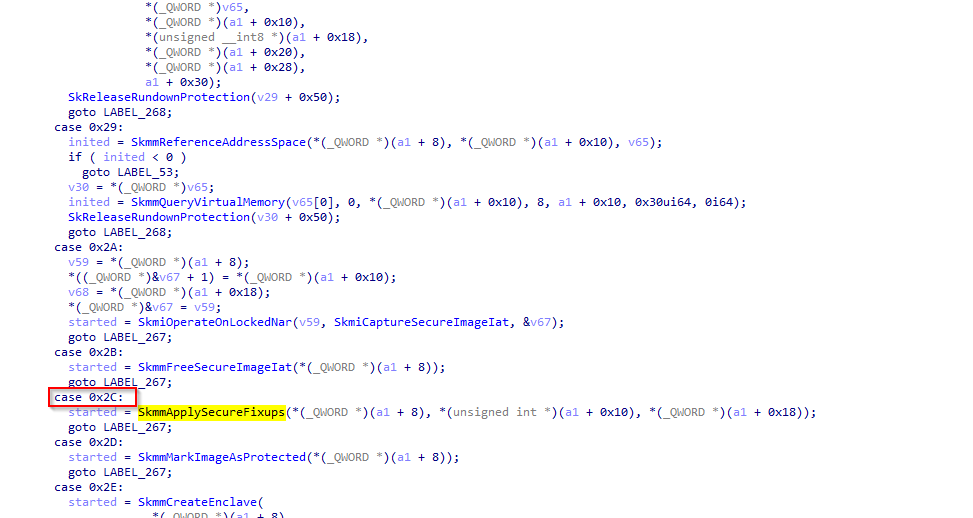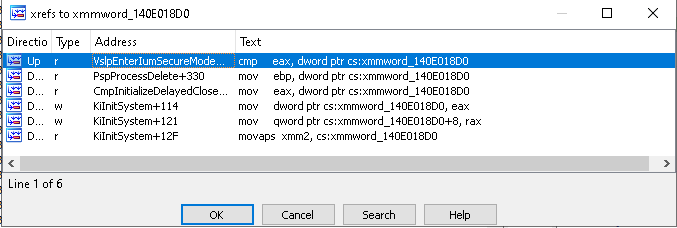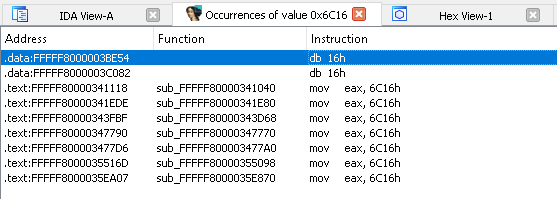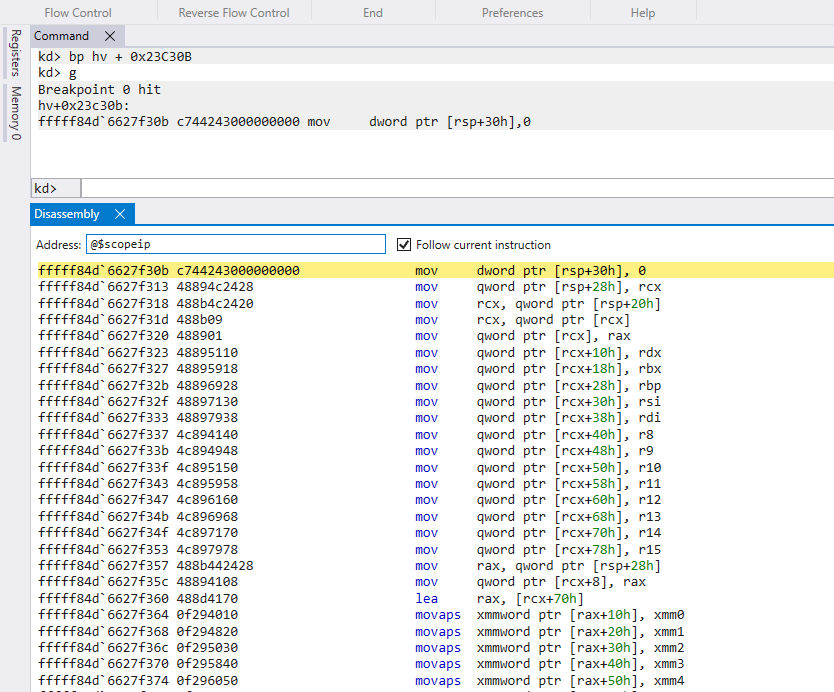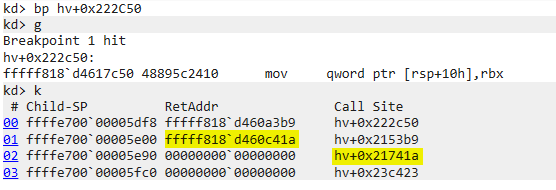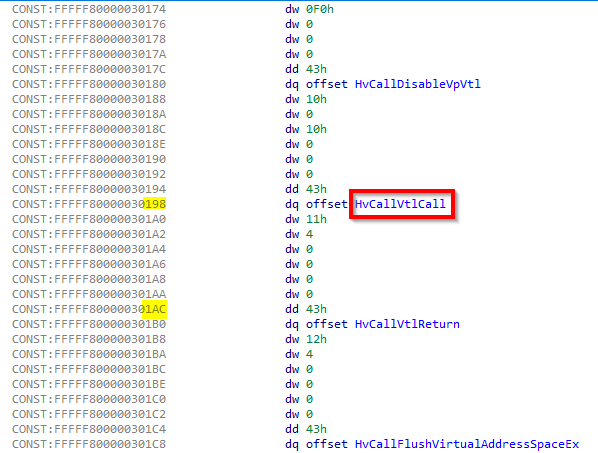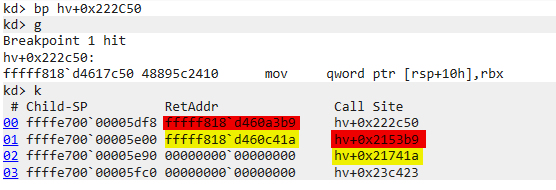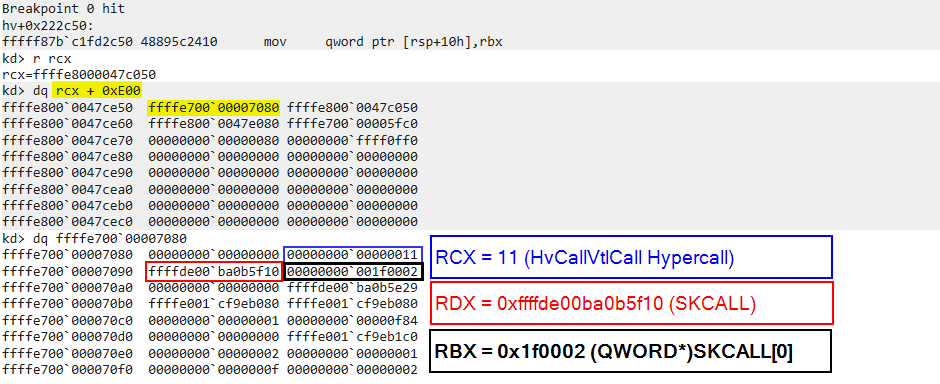Debugging the Windows Hypervisor: Inspecting SK Calls
Introduction & Motivation
Recently, Connor McGarr tweeted about monitoring Secure System Calls while debugging the Windows kernel. I want to take it a step further and monitor the same SK calls while debugging the Windows hypervisor. Exploring Hyper-V’s internals is my goal, as it promises an engaging research experience.
Conditional breakpoint for monitoring Secure System Calls:
— Connor McGarr (@33y0re) May 29, 2024
ba e1 /w "@$curregisters.User.rdx == SECURE_SYSTEM_CALL_NUMBER" nt!VslpEnterIumSecureMode
Useful for dynamic parameter inspection since the calls aren't really all that documented! pic.twitter.com/4uSpw7HzL7
Debugging Setup
Guest
For this blog post, I’ll be using VMware Workstation 17 Professional (which now is free!) and I’ll be running Windows 11 Pro Version 23H2 (OS Build 22631.2861) as my guest.
First, ensure that the option Virtualize Intel VT-x/EPT or AMD-V/RVI under the Processors settings is enabled.
Next, within the VM we are going to enable Virtualization-based security (VBS) and memory integrity.
The last step for the guest VM is to configure the settings for hypervisor debugging, open CMD as administrator, and type:
bcdedit /hypervisorsettings net hostip:192.168.100.1 port:50001 key:a.b.c.d
bcdedit /set hypervisordebug on
NOTE: Set the
hostipandportaccording to your environment
Host
For the host, we can use Windows 10 Anniversary Update (version 1607) or newer (including any Windows 11 version). This requirement is because we are going to use the new WinDbg.
Hyper-V Reverse-Engineering
Hyper-V technology is both extensive and complex, encompassing numerous components. As the title suggests, our focus will be on hvix64.exe, the essential core of the Windows hypervisor specifically designed for Intel processors. Although hvix64.exe lacks symbols—which might seem like a disadvantage (or perhaps a twist of fate that brought us here) — we do have an older version1 with symbols available.
Thankfully, insights into the internals of Hyper-V have been provided by various researchers. Furthermore, a researcher named Gerhart advised in his blog post to conduct a bindiff of hvix64.exe with binaries such as winload.efi and older versions of hvloader.dll, as they share some of the same functionality in their code. Additionally, he published an IDAPython script that locates essential information in hvix64.exe. For further resources on Hyper-V internals, you can check out this link.
Before diving into your own research, it’s always worth reviewing past research. This can help you gain a better understanding and might also provide useful tools for your own research.
Hyper-V Hypercall Interface
In addition, the Hypervisor Top Level Functional Specification (TLFS) provides us with detailed information about the Hypercall Interface. In this post, we are going to focus on the VTL Call.
Secure Kernel (SK) Calls
The NT kernel (NTOS, ring0VTL0) can access secure services provided by the Secure Kernel (ring0VTL1) by issuing a VTL call, which involves transitioning from VTL0 to VTL1. This process is initiated by NTOS using a hypercall with the call code 0x11, known as the HvCallVtlCall hypercall. Each secure service is uniquely identified by a secure service call number (SSCN).
In this post, the terms SK Call and VTL Call are used interchangeably; they mean the same thing.
For more information about VSM and VTL, please refer to this link.
To execute HvCallVtlCall, NTOS uses the function chain VslpEnterIumSecureMode, which calls HvlSwitchToVsmVtl1, which in turn calls HvlpSwitchToVsmVtl1RetpolineHelper, ultimately jumping to HvlpVsmVtlCallVa. HvlpVsmVtlCallVa is a global variable that points to the hypercall page trampoline for issuing the 0x11 hypercall. NTOS functions that require secure services call VslpEnterIumSecureMode.
VslpEnterIumSecureMode, like the other functions mentioned above, is undocumented2. However, fortunately, there is quite a bit of information about it available online. VslpEnterIumSecureMode takes four arguments: the first parameter is of type unsigned int8, the second is unsigned int16, the third is int, and the fourth is PVOID. NTOS specifies the SSCN as the second argument to the VslpEnterIumSecureMode function.
In addition, as noted in Windows Internals2, the VslpEnterIumSecureMode function receives a parameter that points to a 104 (0x68) byte data structure known as SKCALL. SKCALL describes the operation type (such as invoking a secure service, flushing the TB, resuming a thread, or calling an enclave), the SSCN, and up to 12 qword parameters. Note that SKCALL should contain the SSCN, so we expect VslpEnterIumSecureMode or another function in the call chain to write it there. We’ll look at this soon.
We can verify these two parameters by examining the code.
In blue - SKCALL argument.
In red - SSCN.
The verification of the SSCN can be performed by examining the code of securekernel!IumInvokeSecureService, which includes symbols. This function contains a large switch case that identifies the SSCN:
I was curious about the number of calls made to the VslpEnterIumSecureMode function and their specific details. Initially, I manually examined some of these calls and noticed that in almost all cases, the first argument is set to 2, while the third argument is set to 0.
In ntoskrnl.exe3 on the guest machine, there are at least 158 references to the VslpEnterIumSecureMode function. Therefore, I decided to write an IDAPython script to analyze these calls and save the results to a file.
1
2
3
4
5
6
7
8
9
10
11
12
13
14
15
16
17
18
19
20
21
22
23
24
25
26
27
28
29
30
31
32
33
34
35
36
37
38
39
40
41
42
43
44
45
46
47
48
49
50
51
52
53
54
55
56
57
58
59
60
61
62
63
64
65
66
67
68
69
70
71
72
73
74
75
76
77
78
79
80
81
82
83
84
85
86
87
88
89
90
91
92
93
94
"""
Author: Dor00tkit (https://github.com/Dor00tkit/)
Date: October 14, 2024
Description: This Python script analyzes decompiled code to find and list all calls to a specified function,
and writes the results to a text file.
The output file will contain lines in the following format:
- Calling Function: The name of the function that makes the call.
- Call: The call to the target function, including its arguments.
Example output:
KeBalanceSetManager: VslpEnterIumSecureMode(2u, 0xD1, 0, (__int64)v17)
VslExchangeEntropy: VslpEnterIumSecureMode(2u, 0x22, 0, (__int64)v4)
"""
import ida_hexrays
import idautils
import ida_xref
import idaapi
import idc
def get_all_xref_to(addr) -> list:
"""
Retrieves all cross-references (xrefs) to a specified address.
This function iterates through all cross-references to the given address and
collects them in a list.
:param int addr: The address to find cross-references to.
:return: List of xrefs to the specified address
"""
all_xref_to = []
for ref in idautils.XrefsTo(addr):
all_xref_to.append(ref)
return all_xref_to
def trace_function_calls(target_func_name):
"""
Traces all calls to a specified target function and writes the output to a text file.
The function identifies the addresses of all calls to the target function within the
decompiled code, retrieves the calling function names, and writes the call details
to an output file.
:param str target_func_name: The name of the target function to trace
:return:
"""
xref_to_target = []
output = []
target_func_addr = idaapi.get_name_ea(0, target_func_name)
if target_func_addr == idaapi.BADADDR:
print(f"Can`t find {target_func_name}. Abort!")
return
xref_to_target = get_all_xref_to(target_func_addr)
print(f"[+] Found {len(xref_to_target)} xref to {target_func_name}")
ida_hexrays.init_hexrays_plugin()
for idx, xref in enumerate(xref_to_target):
# ida_xref.fl_CN = Call Near, ida_xref.fl_JF = Jump Far
if xref.type == ida_xref.fl_CN or xref.type == ida_xref.fl_JF:
# print(f"[DEBUG] #{idx + 1} current xref: {hex(xref.frm)}")
# print(f"[DEBUG] #{idx + 1} get_func({hex(xref.frm)}): {hex(f.start_ea)}\n")
f = idaapi.get_func(xref.frm)
idaapi.open_pseudocode(xref.frm, ida_hexrays.OPF_REUSE)
cfunc = ida_hexrays.decompile(xref.frm)
for cf in cfunc.treeitems:
if cf.op == idaapi.cot_call:
if 'obj_ea' in cf.cexpr.x.operands:
if cf.cexpr.x.operands['obj_ea'] == target_func_addr:
print(f"[DEBUG] Found a call to ({target_func_name})\n")
decompiled_call_string = cf.cexpr.dstr()
called_from = idc.get_func_name(f.start_ea)
output.append(f"{called_from}: {decompiled_call_string}")
if output:
with open(f"output_{target_func_name}.txt", 'w') as file:
file.write("\n".join(output) + "\n")
def main():
trace_function_calls("VslpEnterIumSecureMode")
if __name__ == '__main__':
main()
After filtering out duplicates, the analysis revealed that nearly all calls to VslpEnterIumSecureMode have 2 as the first argument and 0 as the third argument. However, only 3 out of the 156 calls use different values for the first and third arguments:
1
2
3
PspSecureThreadStartup: VslpEnterIumSecureMode(0, 0, KeGetCurrentThread()->SecureThreadCookie, (__int64)v9)
VslCallEnclave: VslpEnterIumSecureMode(1u, 0, *a2, (__int64)v17)
MiFlushEntireTbDueToAttributeChange: VslpEnterIumSecureMode(3u, 0, 0, (__int64)v1)
Based on our understanding, the first argument likely represents the operation type. For example:
-
0- resuming a thread. -
1- call to an enclave. -
2- invoking a secure service. -
3- flushing the TB.
1
2
3
4
5
6
7
8
9
10
11
12
13
14
15
16
17
18
19
20
21
22
23
NTSTATUS __fastcall VslpEnterIumSecureMode(unsigned __int8 operation_type, __int16 sscn, int a3, PVOID SKCALL) {
__int16 _operation_type; // r15
char v7; // r13
unsigned __int8 CurrentIrql; // r14
__int16 v9; // dx
__int64 v11; // r9
char v39; // [rsp+3Ah] [rbp-37h]
int _a3; // [rsp+40h] [rbp-31h]
__int64 v47; // [rsp+58h] [rbp-19h]
_operation_type = operation_type;
_a3 = a3;
v7 = 0;
v39 = 0;
CurrentIrql = 0xF;
if (!(unsigned __int8)HvlQueryVsmConnection(0))
return STATUS_DEVICE_NOT_CONNECTED;
*(_BYTE *)v11 = _operation_type; // [1]
*(_WORD *)(v11 + 2) = v9; // [2]
v47 = *(_QWORD *)&KeGetCurrentThread()[1].CurrentRunTime;
/* ... (code omitted for brevity) ... */
}
At [1], the operation_type is set to the byte at offset 0 of the SKCALL data structure (with v11 pointed to by the R9 register, which contains the SKCALL argument). Subsequently, at [2], the SSCN (located in the (R)DX register) is assigned to offsets 2-3 (stored as an int16) of the SKCALL data structure. This will assist us later in identifying SKCALL.
Here’s an interesting snippet I encountered while reviewing the VslpEnterIumSecureMode function:
1
2
3
4
5
6
7
8
9
10
11
NTSTATUS __fastcall VslpEnterIumSecureMode(unsigned __int8 operation_type, __int16 sscn, int a3, SKCallData* SKCALL) {
/* ... (code omitted for brevity) ... */
LABEL_67:
if (SKCALL->sscn < xmmword_140E018D0) {
/* ... (code omitted for brevity) ... */
}
/* ... (code omitted for brevity) ... */
}
We can see that the SSCN is compared to the global variable xmmword_140E018D0. Let’s examine the xref to xmmword_140E018D0:
The global variable xmmword_140E018D0 is initialized in KiInitSystem:
xmmword_140E018D0 is initialized with the value of the global variable KiServiceLimit, representing the total number of system calls in NTOS. However, verification reveals a discrepancy: the number of secure services, as indicated by the securekernel!IumInvokeSecureService switch case, is lower than the KiServiceLimit value. The function securekernel!IumInvokeSecureService supports fewer secure services than the KiServiceLimit would suggest.
Let’s trace the SKCALL argument and observe how it is passed along the call chain until it reaches the VMCALL instruction:
1
2
3
4
5
6
7
8
NTSTATUS __fastcall VslpEnterIumSecureMode(unsigned __int8 operation_type, __int16 sscn, int a3, SKCallData *SKCALL) {
/* ... (code omitted for brevity) ... */
HvlSwitchToVsmVtl1(0, SKCALL, v47);
/* ... (code omitted for brevity) ... */
}
SKCALL is passed as the second argument (RDX) to HvlSwitchToVsmVtl1.
Moving to HvlSwitchToVsmVtl1:
1
2
3
4
5
6
7
8
__int64 __fastcall HvlSwitchToVsmVtl1(__int64 a1, SKCallData *a2_SKCALL, __int64 a3) {
/* ... (code omitted for brevity) ... */
result = (*&HvlpVsmVtlCallVa)(a1, a2_SKCALL, KeGetCurrentIrql(), a3);
/* ... (code omitted for brevity) ... */
}
The second argument, our SKCALL (RDX), is passed unchanged to HvlpVsmVtlCallVa. As observed in the decompilation, IDA has optimized out HvlpSwitchToVsmVtl1RetpolineHelper, which simply jumps to HvlpVsmVtlCallVa. Additionally, an examination of the disassembly reveals that the first qword from SKCALL is stored in the RBX register.
Regarding the examination of HvlpVsmVtlCallVa, it can be a bit tricky because it is initialized at runtime. We have two options:
Static Analysis: We need to carefully trace the initialization of
HvlpVsmVtlCallVa. This involves examining its setup inntoskrnlandhvix64as well. You can refer to the section on Establishing the Hypercall Interface for details on how this mechanism is initialized.-
Dynamic Analysis: Alternatively, you could choose dynamic analysis, which may be a simpler approach. Using the kernel debugger:
1 2 3 4 5 6 7 8 9
kd> u poi(nt!HvlpVsmVtlCallVa) fffff800`0f60000f 488bc1 mov rax,rcx fffff800`0f600012 48c7c111000000 mov rcx,11h fffff800`0f600019 0f01c1 vmcall fffff800`0f60001c c3 ret fffff800`0f60001d 8bc8 mov ecx,eax fffff800`0f60001f b812000000 mov eax,12h fffff800`0f600024 0f01c1 vmcall fffff800`0f600027 c3 ret
HvlpVsmVtlCallVa issues the HvCallVtlCall hypercall.
In the next section, we will cover the process of inspecting SK calls during debugging hvix64.exe.
Inspecting SK Calls while debugging hvix64.exe
And now, the real fun starts!
Where should we start?
A good starting point is to consider looking at HvCallVtlCall. Since hvix64.exe does not include symbols, finding HvCallVtlCall might seem challenging. However, as described in First Steps in Hyper-V Research, Hyper-V organizes its hypercalls in a table located in the CONST section. Additionally, as previously mentioned, there is an IDAPython script that can locate the hypercalls.
hvix64!HvCallVtlCall:
1
2
3
4
5
6
7
8
9
10
11
12
13
14
15
16
17
18
19
20
21
22
23
24
HV_STATUS __fastcall HvCallVtlCall(__int64 a1, __int64 a2, __int64 a3) {
unsigned __int16 v3; // bx
int v5; // eax
bool v6; // zf
int v7; // esi
__int64 v8; // r8
unsigned int v9; // edx
v3 = 0;
v5 = 1 << *(*(a1 + 0x340) + 0x14);
v6 = !_BitScanForward(&v7, *(a1 + 0x140) & ~(v5 | (v5 - 1)));
if (v6 || a3) {
return HV_STATUS_GUEST_INVALID_OPCODE_FAULT;
} else {
sub_FFFFF812A752C9D4();
sub_FFFFF812A7527F04(a1, v7);
v8 = *(a1 + 8 * v7 + 0x328);
*(a1 + 0x348) |= 1 << v7;
_BitScanReverse(&v9, *(a1 + 0x348));
*(a1 + 0x34C) = v9;
*(*(v8 + 0x30) + 8) = 1;
}
return v3;
}
At first glance, it seems challenging to grasp what is truly happening in this code. The parameters being passed are unknown. Moreover, if you review the HvCallVtlCall documentation, you will notice that it does not take any parameters. But how does that make sense? The function’s primary job is to perform the VTL switch, ignoring the parameters passed by NTOS, as they are intended for the securekernel.
What is our next step? Consider this: if we can identify the original RDX value at the moment of the VMCALL within the context of the HvCallVtlCall function, we can determine which SSCN is involved. However, to achieve this, we will need to trace the steps backward and connect the dots.
To observe the values of the registers immediately after the execution of the VMCALL instruction, we need to locate the VM-Exit handler.
Finding the VM-Exit Handler
The easiest way to find the VM-Exit handler is to use a debugger. Stepping into the VMCALL instruction to enter the VMM context. This is similar to using a kernel debugger with the SYSCALL instruction. However, this method typically requires a JTAG debugger4 (or perhaps not? I will explore this topic further next year).
As suggested in First Steps in Hyper-V Research, before diving into dynamic analysis, we should begin with static analysis to gain a better understanding of the underlying mechanisms. This analysis will help us identify key functions, such as hypercalls (which we have already mapped out using the IDAPython script), the MSR read/write handler, the functions that interact with the VMCS, and the VM-Exit handler.
A highly effective technique for locating the VM-Exit handler and other relevant elements within the VMCS is to search for their write/read operations. For instance, in our case, we can search for the encoding value of the HOST_RIP field:
As you can see, there are not too many results, which is beneficial. Some of these can be disregarded, as they are related to the VMREAD instruction or are part of an array that includes other VMCS field encodings. The following result appears promising:
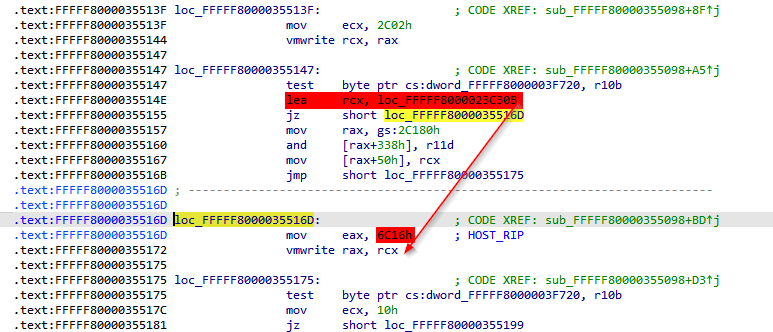
loc_FFFFF8000023C30B (RVA: 0x23C30B): 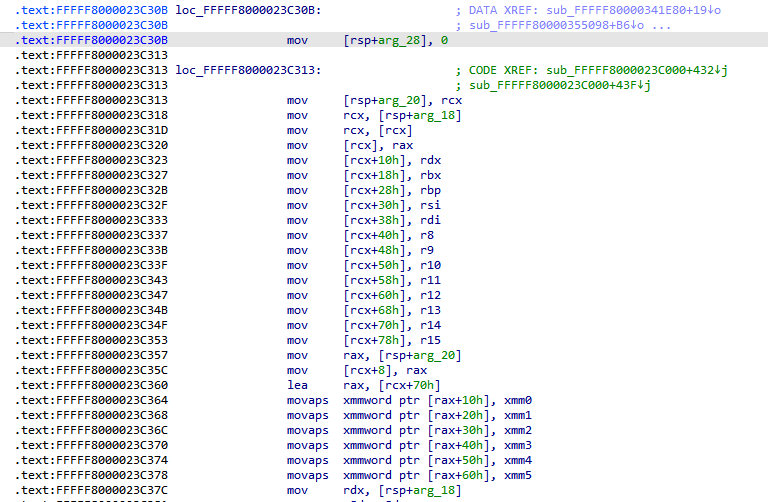
As observed, the snippet begins by saving the general-purpose registers (GPR) and the XMM registers, which is a positive indication. To confirm that it is the VM-Exit handler, we will need to verify it through a debugger:
Some of you might wonder why I chose a software breakpoint (0xCC) over a hardware breakpoint.
The answer is that, despite my attempts, hardware breakpoints failed to work, so I explored the Intel SDM (Volume 3) to determine if I missed something. In the VM Exits chapter, there is a section called Loading Host State, which includes a sub-section named Loading Host Control Registers, Debug Registers, MSRs that contains the following:
28.5.1 Loading Host Control Registers, Debug Registers, MSRs
VM exits load new values for controls registers, debug registers, and some MSRs:
[… omitted for brevity …]
- DR7 is set to 400H
This action will cause the hardware breakpoints to be reset.
I might be wrong, and the explanation could be entirely different. If anyone has insights to share, I’d be glad to hear them.
As we observe what happens next, we will see that the VM-Exit handler reads the Exit reason field quite early (lines 60-61) :
1
2
3
4
5
6
7
8
9
10
11
12
13
14
15
16
17
18
19
20
21
22
23
24
25
26
27
28
29
30
31
32
33
34
35
36
37
38
39
40
41
42
43
44
45
46
47
48
49
50
51
52
53
54
55
56
57
58
59
60
61
62
63
.text:FFFFF8000023C30B loc_FFFFF8000023C30B: ; DATA XREF: sub_FFFFF80000341E80+19↓o
.text:FFFFF8000023C30B ; sub_FFFFF80000355098+B6↓o ...
.text:FFFFF8000023C30B mov dword ptr [rsp+30h], 0
.text:FFFFF8000023C313
.text:FFFFF8000023C313 loc_FFFFF8000023C313: ; CODE XREF: sub_FFFFF8000023C000+432↓j
.text:FFFFF8000023C313 ; sub_FFFFF8000023C000+43F↓j
.text:FFFFF8000023C313 mov [rsp+28h], rcx
.text:FFFFF8000023C318 mov rcx, [rsp+20h]
.text:FFFFF8000023C31D mov rcx, [rcx]
.text:FFFFF8000023C320 mov [rcx], rax
.text:FFFFF8000023C323 mov [rcx+10h], rdx
.text:FFFFF8000023C327 mov [rcx+18h], rbx
.text:FFFFF8000023C32B mov [rcx+28h], rbp
.text:FFFFF8000023C32F mov [rcx+30h], rsi
.text:FFFFF8000023C333 mov [rcx+38h], rdi
.text:FFFFF8000023C337 mov [rcx+40h], r8
.text:FFFFF8000023C33B mov [rcx+48h], r9
.text:FFFFF8000023C33F mov [rcx+50h], r10
.text:FFFFF8000023C343 mov [rcx+58h], r11
.text:FFFFF8000023C347 mov [rcx+60h], r12
.text:FFFFF8000023C34B mov [rcx+68h], r13
.text:FFFFF8000023C34F mov [rcx+70h], r14
.text:FFFFF8000023C353 mov [rcx+78h], r15
.text:FFFFF8000023C357 mov rax, [rsp+28h]
.text:FFFFF8000023C35C mov [rcx+8], rax
.text:FFFFF8000023C360 lea rax, [rcx+70h]
.text:FFFFF8000023C364 movaps xmmword ptr [rax+10h], xmm0
.text:FFFFF8000023C368 movaps xmmword ptr [rax+20h], xmm1
.text:FFFFF8000023C36C movaps xmmword ptr [rax+30h], xmm2
.text:FFFFF8000023C370 movaps xmmword ptr [rax+40h], xmm3
.text:FFFFF8000023C374 movaps xmmword ptr [rax+50h], xmm4
.text:FFFFF8000023C378 movaps xmmword ptr [rax+60h], xmm5
.text:FFFFF8000023C37C mov rdx, [rsp+20h]
.text:FFFFF8000023C381 xor r8d, r8d
.text:FFFFF8000023C384 xor r9d, r9d
.text:FFFFF8000023C387 xor r10d, r10d
.text:FFFFF8000023C38A xor r11d, r11d
.text:FFFFF8000023C38D pxor xmm0, xmm0
.text:FFFFF8000023C391 pxor xmm1, xmm1
.text:FFFFF8000023C395 pxor xmm2, xmm2
.text:FFFFF8000023C399 pxor xmm3, xmm3
.text:FFFFF8000023C39D pxor xmm4, xmm4
.text:FFFFF8000023C3A1 pxor xmm5, xmm5
.text:FFFFF8000023C3A5 xor ebp, ebp
.text:FFFFF8000023C3A7 xor ebx, ebx
.text:FFFFF8000023C3A9 xor esi, esi
.text:FFFFF8000023C3AB xor edi, edi
.text:FFFFF8000023C3AD xor r12d, r12d
.text:FFFFF8000023C3B0 xor r13d, r13d
.text:FFFFF8000023C3B3 xor r14d, r14d
.text:FFFFF8000023C3B6 xor r15d, r15d
.text:FFFFF8000023C3B9 mov [rsp+28h], rbx
.text:FFFFF8000023C3BE and byte ptr gs:74h, 0F9h
.text:FFFFF8000023C3C7 call sub_FFFFF800002396E0
.text:FFFFF8000023C3CC mov byte ptr gs:75h, 0
.text:FFFFF8000023C3D5 mov rcx, [rsp+20h]
.text:FFFFF8000023C3DA mov byte ptr [rcx-0A7Bh], 0
.text:FFFFF8000023C3E1 test byte ptr cs:dword_FFFFF8000003F720, 1
.text:FFFFF8000023C3E8 jnz short loc_FFFFF8000023C3F7
.text:FFFFF8000023C3EA mov eax, 4402h
.text:FFFFF8000023C3EF vmread rsi, rax
.text:FFFFF8000023C3F2 movzx esi, si
.text:FFFFF8000023C3F5 jmp short loc_FFFFF8000023C407
Here is a command to log the VM-exit reason:
1
bp hv+0x23c3f2 ".printf \"VM-Exit Reason(%x)\\n\", @si; gc"
Here is a command to set a conditional breakpoint when the VM-Exit reason equals 0x12 (VMCALL):
1
bp hv+0x23c3f2 ".if (@esi == 0x12) {.echo Break on VMCALL} .else {gc}"
So, what is the next step? We should trace the process of how the general-purpose registers (GPRs) are preserved and then determine how to access them in the context of the HvCallVtlCall function.
You might wonder why a conditional breakpoint on the VM-Exit reason is not used. The main issue is that the location of this breakpoint tends to be very noisy and inefficient. Additionally, hitting this breakpoint does not necessarily indicate that it is due to the
HvCallVtlCallhypercall, as there are many other hypercalls that require additional conditions, making the conditional breakpoint more complicated.
Tracking GPRs State
Let’s revisit the VM-Exit entrypoint:
1
2
3
4
5
6
7
8
9
10
11
12
13
14
15
16
17
18
19
20
21
22
23
24
25
26
27
28
29
30
31
32
33
34
35
36
37
38
39
40
41
42
43
44
45
46
47
48
49
50
51
52
53
.text:FFFFF8000023C30B loc_FFFFF8000023C30B:
.text:FFFFF8000023C30B
.text:FFFFF8000023C30B mov dword ptr [rsp+30h], 0
.text:FFFFF8000023C313
.text:FFFFF8000023C313 loc_FFFFF8000023C313:
.text:FFFFF8000023C313
.text:FFFFF8000023C313 mov [rsp+28h], rcx ; [1]
.text:FFFFF8000023C318 mov rcx, [rsp+20h] ; [2]
.text:FFFFF8000023C31D mov rcx, [rcx] ; [3]
.text:FFFFF8000023C320 mov [rcx], rax ; [4]
.text:FFFFF8000023C323 mov [rcx+10h], rdx
.text:FFFFF8000023C327 mov [rcx+18h], rbx
.text:FFFFF8000023C32B mov [rcx+28h], rbp
.text:FFFFF8000023C32F mov [rcx+30h], rsi
.text:FFFFF8000023C333 mov [rcx+38h], rdi
.text:FFFFF8000023C337 mov [rcx+40h], r8
.text:FFFFF8000023C33B mov [rcx+48h], r9
.text:FFFFF8000023C33F mov [rcx+50h], r10
.text:FFFFF8000023C343 mov [rcx+58h], r11
.text:FFFFF8000023C347 mov [rcx+60h], r12
.text:FFFFF8000023C34B mov [rcx+68h], r13
.text:FFFFF8000023C34F mov [rcx+70h], r14
.text:FFFFF8000023C353 mov [rcx+78h], r15 ; [5]
.text:FFFFF8000023C357 mov rax, [rsp+28h] ; [6]
.text:FFFFF8000023C35C mov [rcx+8], rax ; [7]
.text:FFFFF8000023C360 lea rax, [rcx+70h]
.text:FFFFF8000023C364 movaps xmmword ptr [rax+10h], xmm0
.text:FFFFF8000023C368 movaps xmmword ptr [rax+20h], xmm1
.text:FFFFF8000023C36C movaps xmmword ptr [rax+30h], xmm2
.text:FFFFF8000023C370 movaps xmmword ptr [rax+40h], xmm3
.text:FFFFF8000023C374 movaps xmmword ptr [rax+50h], xmm4
.text:FFFFF8000023C378 movaps xmmword ptr [rax+60h], xmm5
; ... (code omitted for brevity) ...
.text:FFFFF8000023C3D5 mov rcx, [rsp+20h] ; [8]
; ... (code omitted for brevity) ...
.text:FFFFF8000023C3EA mov eax, 4402h ; Exit Reason
.text:FFFFF8000023C3EF vmread rsi, rax
.text:FFFFF8000023C3F2 movzx esi, si
.text:FFFFF8000023C3F5 jmp short loc_FFFFF8000023C407
.text:FFFFF8000023C407 loc_FFFFF8000023C407:
.text:FFFFF8000023C407 cmp si, 1 ; EXIT_REASON_EXTERNAL_INTERRUPT
.text:FFFFF8000023C40B jnz short loc_FFFFF8000023C417
.text:FFFFF8000023C40D call sub_FFFFF8000023B690
.text:FFFFF8000023C412 mov rcx, [rsp+20h]
.text:FFFFF8000023C417
.text:FFFFF8000023C417 loc_FFFFF8000023C417: ; CODE XREF: sub_FFFFF8000023C000+40B↑j
.text:FFFFF8000023C417 sti
.text:FFFFF8000023C418 mov edx, esi ; [9]
.text:FFFFF8000023C41A or edx, [rsp+30h]
.text:FFFFF8000023C41E call sub_FFFFF80000216FA0 ; [10]
.text:FFFFF8000023C423 jmp loc_FFFFF8000023C140
At [1], the value of RCX is saved at [RSP+28h] to preserve it. At [2], RCX is loaded with the address of an internal hvix64 data structure from [RSP+20h] (referred to as hvix_ctx). At [3], RCX is dereferenced to access the guest_saved_state data structure. The guest_saved_state is a dedicated data structure allocated by hvix64 for storing the guest GPRs and XMM registers. Between [4] and [5], various GPRs are saved into the guest_saved_state structure. At [6] and [7], the previously saved value of RCX (from step [1]) is saved into the guest_saved_state structure.
Next, at [8], RCX is reloaded with the address of the hvix_ctx structure from [RSP+20h]. At [9], the ESI register, which contains the Exit reason, is copied to EDX. Finally, at [10], the function sub_FFFFF80000216FA0 is called with the hvix_ctx structure as the first argument and the Exit reason as the second argument.
The hvix_ctx data structure is pre-allocated for each logical processor and is used to store critical data structures necessary for managing the virtual machines. Currently, we know that the guest_saved_state structure is located at offset 0 within this structure.
Moving on to sub_FFFFF80000216FA0, this function is extensive and is designed to parse the Exit reason and handle the VM-Exit appropriately. It parses the Exit reason using a comprehensive switch case statement that is quite noticeable:
1
2
3
4
5
6
7
8
9
10
11
12
13
14
15
16
17
18
19
20
21
22
23
24
25
26
27
28
29
30
31
32
33
34
35
36
37
38
39
40
41
42
43
44
45
46
47
48
49
50
51
52
53
54
55
56
57
58
59
60
61
62
63
64
65
66
67
68
69
70
71
72
73
74
75
76
77
78
79
80
81
82
83
84
85
86
87
88
89
90
91
92
__int64 __fastcall sub_FFFFF80000216FA0(unsigned int **a1, unsigned int a2) {
/* ... (code omitted for brevity) ... */
/* ... (code omitted for brevity) ... */
/* ... (code omitted for brevity) ... */
switch (a2) {
case EXIT_REASON_MSR_WRITE:
/* ... (code omitted for brevity) ... */
case EXIT_REASON_EXTERNAL_INTERRUPT:
/* ... (code omitted for brevity) ... */
case EXIT_REASON_VMCALL:
*(_DWORD *)(*(_QWORD *)(v6 + 0x108) + 0x178) = 9;
v25 = *(char *)(*(_QWORD *)(v6 + 0x388) + 0xE0) < 0;
v26 = *(_QWORD *)(v6 + 0x340);
if (*(_DWORD *)(v26 + 0x12A0) == 3) {
v27 = 1;
*(_BYTE *)(v6 + 0x18) = 1;
if (v25) goto LABEL_221;
*(_QWORD *)(v6 + 0x10) = *(_QWORD *)(*(_QWORD *)(v26 + 0x30) + 0x20);
if ((*(_DWORD *)(v6 + 0x10) & 1) == 0) goto LABEL_221;
} else {
v27 = 0;
*(_BYTE *)(v6 + 0x18) = 0;
}
v28 = *(_QWORD *)(v6 + 0x340);
v174 = 0;
if ((*(_BYTE *)(*(_QWORD *)(v28 + 0x10A8) + 0x138) & 1) != 0) {
if (*(_BYTE *)(v28 + 0x10B0)) {
sub_FFFFF80000355ECC((unsigned int *)(v28 + 0x1080), 0x60002, &v174);
LOWORD(_RAX) = v174;
} else {
v175 = 0;
if ((dword_FFFFF8000003F720 & 1) != 0) {
LODWORD(_RAX) = *(_DWORD *)(*(_QWORD *)&NtCurrentTeb()[0x1D].GdiTebBatch.Buffer[0xF2] + 0xC0);
} else {
_RAX = GUEST_SS_AR_BYTES;
__asm { vmread rax, rax}
v28 = *(_QWORD *)(v6 + 0x340);
v175 = _RAX;
}
}
v31 = ((unsigned __int64)(unsigned __int16)_RAX >> 5) & 3;
} else {
v31 = 0;
}
if (!(v31 | ((*(_QWORD *)(*(_QWORD *)(v28 + 0x10A8) + 0x110) & 1) == 0))) {
v32 = *(_QWORD *)&NtCurrentTeb()[0xA].StaticUnicodeBuffer[0x20];
v174 = 0;
if (*(_BYTE *)(*(_QWORD *)(v32 + 0x340) + 0x10B0)) {
sub_FFFFF80000355ECC((unsigned int *)(*(_QWORD *)(v32 + 0x340) + 0x1080), 0x60001, &v174);
LODWORD(_RDX) = v174;
} else {
v182 = 0;
if ((dword_FFFFF8000003F720 & 1) != 0) {
LODWORD(_RDX) = *(_DWORD *)(*(_QWORD *)&NtCurrentTeb()[0x1D].GdiTebBatch.Buffer[0xF2] + 0xBC);
} else {
_RAX = GUEST_CS_AR_BYTES;
__asm { vmread rdx, rax}
v28 = *(_QWORD *)(v6 + 0x340);
v182 = _RDX;
}
}
if ((_RDX & 0x10000) != 0) LOWORD(_RDX) = 0;
v35 = ((unsigned __int16)_RDX &
((unsigned __int64)*(unsigned int *)(*(_QWORD *)(v28 + 0x10A8) + 0x110) >> 1) & 0x2000) != 0;
v192 = 0;
v189 = v6;
v191 = v35;
v190 = 0;
sub_FFFFF80000215080(v6, 0, v35, (unsigned int *)&v189);
break;
}
if (!v27) {
if (v25 && *(_BYTE *)(*(_QWORD *)(v6 + 0x388) + 0x3E46)) {
sub_FFFFF800002DB44C(v6, 0, 0);
} else {
*(_QWORD *)(v6 + 0x14) = 6;
*(_BYTE *)(v6 + 0x10) = 0;
*(_QWORD *)(v6 + 0x20) = 0;
*(_DWORD *)v6 = 7;
}
break;
}
LABEL_221:
sub_FFFFF8000037FEA0(v6, 0x12, 0, *(unsigned __int8 *)(v6 + 8));
break;
case EXIT_REASON_HLT:
/* ... (code omitted for brevity) ... */
}
/* ... (code omitted for brevity) ... */
}
While examining the VMCALL handling reveals several operations that may not provide clear insights, it is noticeable that there are references to four functions: sub_FFFFF80000355ECC is referenced twice, while sub_FFFFF80000215080, sub_FFFFF800002DB44C, and sub_FFFFF8000037FEA0 are each referenced once.
How do we determine which function to focus on? Fortunately, we have only four functions to consider, which is a relatively small number. We can examine them one by one in chronological order. Alternatively, and often more effectively, we can use dynamic analysis. In this case, setting a breakpoint in HvCallVtlCall and then examining the call stack can provide valuable insights:
Correlate with IDA:
sub_FFFFF80000215080 appears to be the function we should focus on. Additionally, a brief examination reveals that it references the global hypercalls table (HvCallTable). This is a strong indication. Why? Because the hypervisor needs to parse the RCX register to determine the requested hypercall, as it holds the relevant information. Bingo!
Before reviewing sub_FFFFF80000215080, we must first understand the parameters that are passed to it:
1
2
3
4
5
6
7
8
/* ... (code omitted for brevity) ... */
v35 = ((unsigned __int16)_RDX &((unsigned __int64)*(unsigned int *)(*(_QWORD *)(v28 + 0x10A8) + 0x110) >> 1) & 0x2000) != 0;
v192 = 0;
v189 = v6;
v191 = v35;
v190 = 0;
sub_FFFFF80000215080(v6, 0, v35, &v189);
/* ... (code omitted for brevity) ... */
v35 is a boolean, and v189 contains v6. To determine the value of v6, we need to trace back through the code:
1
v6 = a1 + 0xFFFFFE40;
a1 is the first argument of the current function (sub_FFFFF80000216FA0), pointing to the hvix_ctx structure. As previously mentioned, hvix_ctx contains a pointer to the guest_saved_state structure at offset 0.
But what is this strange access: + 0xFFFFFE40? Let’s take a look at the disassembly of this instruction:
1
2
3
.text:FFFFF80000216FDE mov r12, rcx
; ... (code omitted for brevity) ...
.text:FFFFF80000217009 lea rdi, [r12-0E00h]
v6 is located 0xE00 bytes behind the start of the hvix_ctx structure.
Moving to sub_FFFFF80000215080, although the function is complex, we will focus on how it accesses the global hypercalls table (HvCallTable):
1
2
3
4
5
6
7
8
9
10
11
12
13
__int64 __fastcall sub_FFFFF80000215080(__int64 a1, __int64 a2, __int64 a3, unsigned int *a4) {
/* ... (code omitted for brevity) ... */
if ((v16 & 0x80u) == 0 || sub_FFFFF800002A65D4(v14, v12, a3, v13)) {
v17 = *((unsigned __int16 *)&HvCallTable + 0xC * (v12 & 0x3FFF) + 0xA);
v18 = &HvCallTable + 3 * (v12 & 0x3FFF);
++*(_QWORD *)(*(_QWORD *)(*(_QWORD *)(a1 + 0x108) + 0x13B8) + 8 * v17);
goto LABEL_16;
}
/* ... (code omitted for brevity) ... */
}
As you can see, v12 is used when accessing HvCallTable. We need to track v12:
1
v12 = v44;
v44:
1
v44 = v10;
v10:
1
2
3
4
5
6
7
8
9
10
11
12
13
14
if (a3 > 1)
{
v9 = a4 + 8;
}
else
{
v9 = *(*a4 + 0xE00);
if (!a3)
{
v10 = *v9 | (*(v9 + 2) << 0x20);
goto LABEL_4;
}
}
v10 = *((_QWORD *)v9 + 1);
As you can see, v9 depends on the third argument. If this argument is greater than 1, the if code block will execute; otherwise, the else code block will execute. Since our third argument is a boolean (v35), the else block will execute regardless of whether it is set to true. Nevertheless, this can be easily verified using the debugger. Let’s see what happened with v9 in the else block:
1
v9 = *(*a4 + 0xE00);
As a reminder, the fourth argument (a4) is a pointer to v189, which contains v6. As mentioned earlier, v6 is positioned 0xE00 bytes behind the hvix_ctx structure. By evaluating v9 = *(*a4 + 0xE00), we effectively navigate back to the hvix_ctx structure and dereference its first element, which points to the guest_saved_state structure. As a result, v9 will point to the guest_saved_state structure.
Revisiting v10, the expression v10 = *((_QWORD *)v9 + 1); assigns the second element of the guest_saved_state structure to v10, which corresponds to the RCX register!
In IDA, we can import the following custom structure to improve the clarity of the decompiled code:
To summarize, v12 contains the saved RCX register. Let’s go back to examining the accesses to the global hypercalls table (HvCallTable) :
1
2
3
4
v17 = *((unsigned __int16 *)&HvCallTable + 0xC * (v12 & 0x3FFF) + 0xA);
v18 = &HvCallTable + 3 * (v12 & 0x3FFF);
++*(_QWORD *)(*(_QWORD *)(*(_QWORD *)(a1 + 0x108) + 0x13B8) + 8 * v17);
goto LABEL_16;
The expression v12 & 0x3FFF extracts 14 bits from RCX, corresponding to the Call code (bits 15-0) that specifies the requested hypercall. In our case RCX = 0x11 (HvCallVtlCall). Let’s carefully examine the expressions, as they involve pointer arithmetic, which can be quite tricky:
-
*((unsigned __int16 *)&HvCallTable + 0xC * (v12 & 0x3FFF) + 0xA);- First, notice thatHvCallTableis treated as an array ofunsigned __int16. To access an element, compute the offset by multiplying0xCby0x11, adding0xA, and then multiplying the result by2because the element size isunsigned __int16(2bytes). The final result is:0x1AC. -
&HvCallTable + 3 * (v12 & 0x3FFF);- This expression is simpler than the previous one.HvCallTableis treated as an array of function pointers, each8bytes in size. To access an element, calculate the offset by multiplying0x3by0x11, and then multiply the result by8to account for the8-bytesize of each element. The final result is:0x198.
In such cases, it is crucial to verify through disassembly that the expressions shown in the decompiled code are accurate.
We can ignore v17 and focus on v18, which now points to HvCallVtlCall:
Determining which cross-reference (xref) to focus on is easier, given that there are only four relevant ones. The last xref is particularly promising because it represents a function call. Applying the previous technique—setting a breakpoint on HvCallVtlCall and checking the call stack—helps confirm that the last xref is our target:
Correlate with IDA:
1
(*v18)(a1, v6, v35, v13)
According to the decompiled code, the current function (sub_FFFFF80000215080) uses its first argument (a1) as the first argument to HvCallVtlCall. As mentioned earlier, a1 is positioned 0xE00 bytes behind the hvix_ctx structure. With this, we can now access the GPRs in the HvCallVtlCall context. In the HvCallVtlCall context, we take the value in the RCX register, add 0xE00 to it, and then dereference the address to access the first qword, which contains the guest_saved_state structure.
Detailed Walkthrough of SK Call Inspection
Let’s see how this can be done with WinDbg:
If we attempt to access SKCALL memory directly, we will notice that it cannot be read:
The hypervisor cannot directly access a guest’s Guest Virtual Address (GVA) because the guest’s virtual address space is separate from the hypervisor’s address space. Instead, modern hypervisors utilize the Second Level Address Translation mechanism to translate Guest Physical Addresses (GPAs) into Host Physical Addresses (HPAs) for accessing the corresponding memory.
For a detailed explanation of how Second-Level Address Translation (SLAT) works in translating memory addresses, please refer to this link.
Fortunately, instead of manually translating GPA to HPA, there are a few scripts that can assist. I chose to use hvext, created by Satoshi Tanda, which is still actively maintained.
In addition, I modified
hvextby adding two new commands:!gva_to_hpaand!read_vmcs.
!gva_to_hpa- Simplifies the translation process from GVA to HPA.!read_vmcs- Reads a specific field from the VMCS using either the field name or its encoding value.
You can check out my modified hvext to see these changes in action.
Translating SKCALL GVA to HPA:

Start by translating the GVA to GPA, and then translate the GPA to HPA. However, as shown in the image above, you’ll notice that the GPA for GUEST_CR3 directly matches the HPA. This one-to-one relationship is called identity-mapping, where GPA equals HPA. Therefore, for our purposes, translating the GVA to GPA alone is sufficient. Additionally, as shown in the image, we validated SKCALL by using the RBX value from the guest_saved_state structure.
Based on the value of SKCALL[0] (byte, offset 0), the operation type is invoking a secure service (value 2). Additionally, SKCALL[2] (int16, offset 2) is 0x1F. Searching for this value (0x1F) in the VslpEnterIumSecureMode calls xref results (generated by the IDAPython script), reveals that this SK Call was invoked by VslValidateDynamicCodePages:
1
VslValidateDynamicCodePages: VslpEnterIumSecureMode(2u, 0x1F, 0, (__int64)v11)
Conclusion
Investigating SK calls within hvix64.exe has revealed key insights into Hyper-V’s inner workings. By analyzing the VM-Exit handler and hypercall interface, we uncovered how guest state information is managed in the hypervisor. Static analysis with IDA, combined with dynamic debugging using WinDbg and hvext, allowed us to examine SK calls in detail, including their types and secure service call numbers.
Thanks
Connor McGarr, Gerhart, Saar Amar, Daniel Fernández, Satoshi Tanda, Aleksandar Milenkoski, Yarden Shafir, Alan Sguigna.
OpenSecurityTraining2 (OST2) ![]() .
.
Recommended Reading
- Hypervisor Top Level Functional Specification
- Windows Internals Book
- Hyper-V debugging for beginners. 2nd edition
- First Steps in Hyper-V Research
- ERNW Newsletter 43 - Security Assessment of Microsoft Hyper-V
- Hyper-V internals researches history (2006-2024)
- A virtual journey: From hardware virtualization to Hyper-V’s Virtual Trust Levels
- Debugging Windows Isolated User Mode (IUM) Processes
- Virtual Secure Mode: Communication Interfaces
- Intel SDM
- Hypervisor From Scratch
- 5 Days to Virtualization: A Series on Hypervisor Development
- MMU Virtualization via Intel EPT

